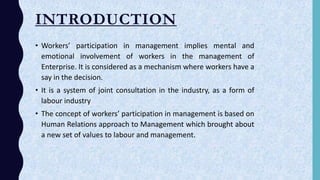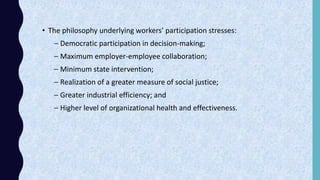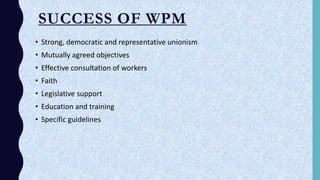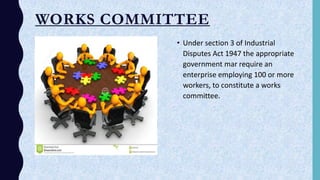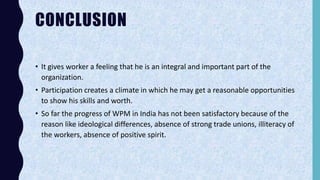Workers participation in management and its present status in india
- 1. WORKERS PARTICIPATION & ITS PRESENT STATUS IN INDIA
- 2. INTRODUCTION • Workers’ participation in management implies mental and emotional involvement of workers in the management of Enterprise. It is considered as a mechanism where workers have a say in the decision. • It is a system of joint consultation in the industry, as a form of labour industry • The concept of workers’ participation in management is based on Human Relations approach to Management which brought about a new set of values to labour and management.
- 3. COLLECTIVE BARGAINING • It is a source of solving the problems of employees in the work situation collectively. • It provides a good climate for discussing the problems of workers with their employers. • The employees put their demands before the employers and the employers also give certain concession to them. Thus it ensures that the management cannot take unilateral decision concerning the work ignoring the workers. • It also helps the workers to achieve responsible wages, working conditions, working hours, fringe benefits etc. • It provides them a collective strength to bargain with employer. It also provides the employers some control over the employees.
- 4. OBJECTIVES OF WPM • Raise the level of motivation of workers • Opportunity of expression and sense of importance to workers • Counter balance power of managers • Establish industrial democracy • Satisfy workers social and esteem needs
- 5. • The philosophy underlying workers’ participation stresses: – Democratic participation in decision-making; – Maximum employer-employee collaboration; – Minimum state intervention; – Realization of a greater measure of social justice; – Greater industrial efficiency; and – Higher level of organizational health and effectiveness.
- 6. IMPORTANCE OF WPM • Reduced industrial conflict • Reduced misunderstandings • Higher productivity • Better communication • Industrial democracy • Less resistance to change
- 7. SUCCESS OF WPM • Strong, democratic and representative unionism • Mutually agreed objectives • Effective consultation of workers • Faith • Legislative support • Education and training • Specific guidelines
- 9. DECISIVE PARTICIPATION ADMINISTRATION PARTICIPATION ASSOCIATIVE PARTICIPATION CONSULTATIVE PARTICIPATION INFORMATIVE PARTICIPATION
- 11. SUGGESTION SCHEME WORKS COMMITTEE JOINT MANAGEMENT COUNCILS BOARD REPRESENTATION CO-PARTNERSHIP WORKERS’ COMPLETE OWNERSHIP
- 13. WORKS COMMITTEE • Under section 3 of Industrial Disputes Act 1947 the appropriate government mar require an enterprise employing 100 or more workers, to constitute a works committee..
- 14. JOINT MANAGEMENT COUNCILS (JMCS) • Introduced in 1958. • Formed at plant level with equal number of representatives from the employers and the employees. • Matters discussed – working conditions, indiscipline, absenteeism, training, safety, accident prevention, etc.
- 15. BOARD REPRESENTATION • One or two representatives of workers are nominated. • Highest form of workers participation • Government itself, as an employer introduced this scheme in several public sector enterprises.
- 16. CO-PARTNERSHIP • Employees participation in the share capital of their own company. • Workers are allowed to make payments in installments, advanced loans or even give financial assistance to workers to buy equity shares of the company.
- 17. WORKERS’ COMPLETE OWNERSHIP • Under this scheme the workers acquire complete control of the management of their enterprise through the elected board. • It is also known as “SELF MANAGEMENT” • This scheme mostly prevails in Yugoslavia.
- 21. BEFORE INDEPENDENCE • In 1920, Mahatma Gandhi has suggested the idea of worker participation in India. • In the same year workers and employees in Ahemdabad Textile industry agreed to settle their disputes by joint discussions and consultations, i.e, participative management in India and such committees were also setup in the Tata Iron and Steel company.Jamshedpur.
- 22. AFTER INDEPENDENCE • The first major step in the direction of workers participation in management in India was the enactment of the INDUSTRIAL DISPUTES ACT,1947 with the dual purpose of prevention and settlement of industrial disputes. • The first five year plan and the successive plans emphasized the need of the workers participation in management. • The government of India set up a “STUDY GROUP ON WORKERS’ PARTICIPATION IN MANAGEMENT”, in 1956 to examine the system of WPM in the UK, Sweden, France, Belgium, Yugoslavia and to make recommendation for the Indian case.
- 23. • Upto July 1975, there had been three forms of workers participation in management introduced in India – Works Committees, Joint Management Councils and Workers- Directors(public sector) on board of director. • In June 1977, the Indian Government setup up a high powered Expert Committee on companies and MRTP Acts under the Chairmanship of Rajinder Sachar. • The Janta Government also set up a “Committee on Workers Participation in Management and Equity” in September 1977 under the Chairmanship of Ravindra Varma, the then Union Minister of Labour. • Finally, in May 25 1990 the “PARTICIPATION OF WORKERS IN MANAGEMENT BILL 1990” was introduced.
- 24. CONCLUSION • It gives worker a feeling that he is an integral and important part of the organization. • Participation creates a climate in which he may get a reasonable opportunities to show his skills and worth. • So far the progress of WPM in India has not been satisfactory because of the reason like ideological differences, absence of strong trade unions, illiteracy of the workers, absence of positive spirit.

